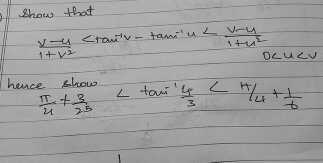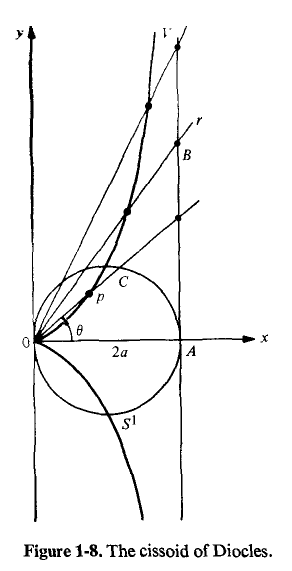Problem:
Solution:
Here I present my solution. The book's solution is MUCH simpler but that is not mine.
We know $ BX : XC = 2:3 $, so let $ \vec{BX} = 2\vec{p} $. $ \vec{XC} = 3\vec{p} $.
Similarly, $ \vec{CY} = \vec{q} $, $ \vec{YA} = 2\vec{q} $.
Let $ \vec{AB} = \vec{r} $, our goal is to compute the length ratios.
$ \vec{AX} = \vec{AB} + \vec{BX} = \vec{r} + \vec{2p} $.
$ \vec{AX} = \vec{AC} + \vec{CX} = (-3\vec{q}) - \vec{3p} $.
Therefore: $ \vec{AX} = \frac{1}{5}(3\vec{r} - 6\vec{q}) $ (Just eliminate $ \vec{p} $ from the equations above)
$ \vec{BY} = \vec{BA} + \vec{AY} = -\vec{r} - 2\vec{q} $
Observe that we have two ways to get to $ O $, either starting from $ A $ or $ B $.
Let $ \vec{AO} = \alpha \vec{AX} $
Let $ \vec{BO} = \beta \vec{BY} $
Now $ \alpha ( \frac{1}{5}(3\vec{r} - 6\vec{q})) = \alpha \vec{AX} = \vec{AO} = \vec{AB} + \vec{BO} = \vec{r} + \beta \vec{BY} = \vec{r} + \beta(-\vec{r} - 2\vec{q}) $
Now the amazing thing happens, we can solve $ \alpha $ and $ \beta $ at the same time by equating coefficients.
$ \alpha ( \frac{1}{5}(3\vec{r} - 6\vec{q})) = \vec{r} + \beta(-\vec{r} - 2\vec{q}) $
$ \frac{3}{5}\alpha = 1 - \beta $ (matching coefficients of $ \vec{r} $)
$ -\frac{6}{5}\alpha = -2\beta $ (matching coefficients of $ \vec{q} $)
Solving, get $ \alpha = \frac{5}{6} $, $ \beta = \frac{1}{2} $.
So $ AO : OX = 5 : 1 $, $ BO : OY = 1 : 1 $.
Next, we tackle the $ CO:OZ $ and $ AZ : ZB $. To do that, we compute $ CO $ in two ways.
Let $ \vec{CO} = \gamma \vec{CZ} $
Let $ \vec{AZ} = \delta \vec{AB} $
$ \vec{CO} = \vec{CB} + \vec{BO} = \vec{CA} + \vec{AB} + \frac{1}{2}\vec{BY} = 3\vec{q} + \vec{r} + \frac{1}{2}(-\vec{r} - 2\vec{q}) = \frac{1}{2}(\vec{r} + 4\vec{q}) $
$ \vec{CZ} = \vec{CA} + \vec{AZ} = \vec{3q} + \delta \vec{AB} = \vec{3q} + \delta\vec{r} $.
Now $ \frac{1}{2}(\vec{r} + 4\vec{q}) \vec{CO} = \gamma \vec{CZ} = \gamma(\vec{3q} + \delta\vec{r}) $
Now we equate coefficients again and get
$ \frac{1}{2} = \gamma \delta $ (matching coefficients of $ \vec{r} $)
$ 2 = 3\gamma $
Solving, get $ \gamma = \frac{2}{3} $, $ \delta = \frac{3}{4} $.
So $ CG : GZ = 2 : 1 $, $ AZ:ZB = 1 : 3 $.
Now at this point, we have all the length ratios we wanted. For triangles with opposite angle, we know triangle area is $ \frac{1}{2}ab\sin\theta $, so the length ratio give us triangle area ratios.
Since we do not need to vectors anymore, abusing the notation, we reuse $ P Q R S T U $ to mean the triangle areas of $ \triangle AOZ, \triangle AOY, \triangle ZOB, \triangle YOC, \triangle BOX, \triangle XOC $.
The length ratios give us these equations:
$ 2P = 5U $
$ R = 2S $
$ 5T = Q $
We wanted $ R + T $, but we do not know $ Q $, so even more is required. Here is another observation, $ \triangle ABX : \triangle ACX = 2:3 $ because they share the same height but with different base, that gives $ 3(P + R + T) = 2(Q + S + U) $, at this point, we can solve $ Q = \frac{5.5U + 4S}{1.4} $, and therefore $ R + T = 2a + \frac{16.5b + 4a}{7} $.
Even then, it is not enough, because we have no matching answer, now we pull in one more equation with the observation that $ \triangle CAE : \triangle CBE = 3:1 $ using the similar argument, now we get 5 equations:
$ 2P = 5U $
$ R = 2S $
$ 5T = Q $
$ 3(P + R + T) = 2(Q + S + U) $
$ P + Q + S = 3(R + T + U) $,
We know these equations will not give an exact answer because it is simply up to scaling. We arbitrarily set $ U = 1 $ and solve these equations (with a solver, coz I am lazy), we finally get our answers.
P = 2.500
Q = 4.722
R = 0.556
S = 0.278
T = 0.944
U = 1.000
So R + T = 1.5 and that is $ \frac{9}{2}\frac{1}{3} = \frac{9b}{2} $
So finally, that's our answer! Phew.





































